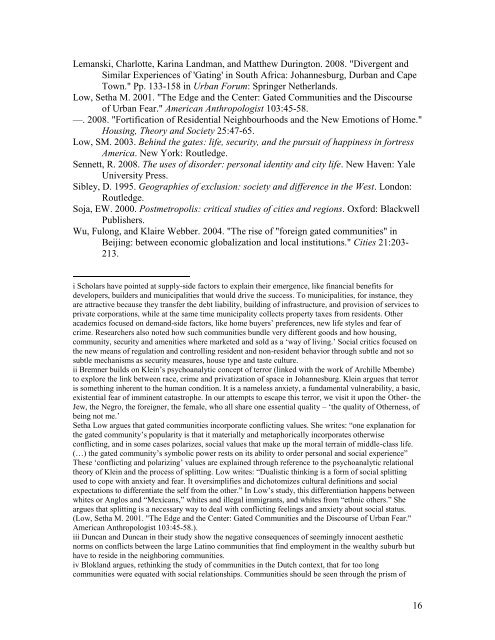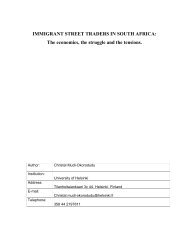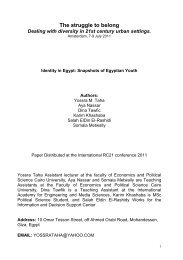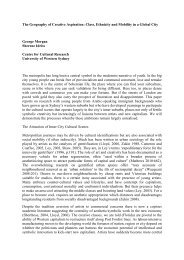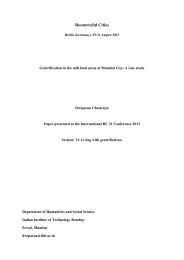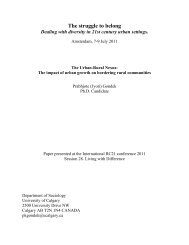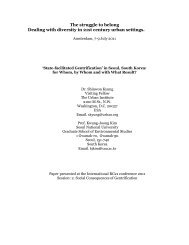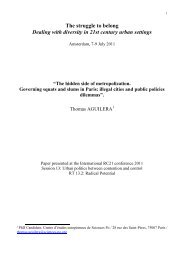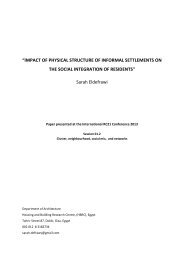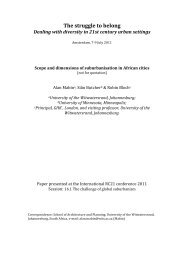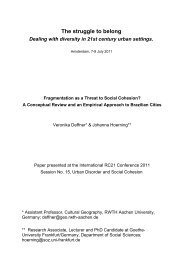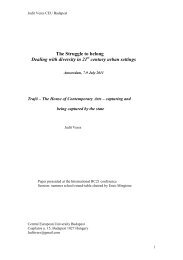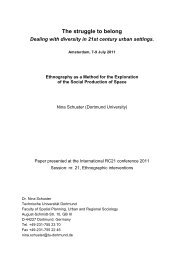White South Africans & The Experience of Gated Living in post ...
White South Africans & The Experience of Gated Living in post ...
White South Africans & The Experience of Gated Living in post ...
You also want an ePaper? Increase the reach of your titles
YUMPU automatically turns print PDFs into web optimized ePapers that Google loves.
Lemanski, Charlotte, Kar<strong>in</strong>a Landman, and Matthew Dur<strong>in</strong>gton. 2008. "Divergent and<br />
Similar <strong>Experience</strong>s <strong>of</strong> 'Gat<strong>in</strong>g' <strong>in</strong> <strong>South</strong> Africa: Johannesburg, Durban and Cape<br />
Town." Pp. 133-158 <strong>in</strong> Urban Forum: Spr<strong>in</strong>ger Netherlands.<br />
Low, Setha M. 2001. "<strong>The</strong> Edge and the Center: <strong>Gated</strong> Communities and the Discourse<br />
<strong>of</strong> Urban Fear." American Anthropologist 103:45-58.<br />
—. 2008. "Fortification <strong>of</strong> Residential Neighbourhoods and the New Emotions <strong>of</strong> Home."<br />
Hous<strong>in</strong>g, <strong>The</strong>ory and Society 25:47-65.<br />
Low, SM. 2003. Beh<strong>in</strong>d the gates: life, security, and the pursuit <strong>of</strong> happ<strong>in</strong>ess <strong>in</strong> fortress<br />
America. New York: Routledge.<br />
Sennett, R. 2008. <strong>The</strong> uses <strong>of</strong> disorder: personal identity and city life. New Haven: Yale<br />
University Press.<br />
Sibley, D. 1995. Geographies <strong>of</strong> exclusion: society and difference <strong>in</strong> the West. London:<br />
Routledge.<br />
Soja, EW. 2000. Postmetropolis: critical studies <strong>of</strong> cities and regions. Oxford: Blackwell<br />
Publishers.<br />
Wu, Fulong, and Klaire Webber. 2004. "<strong>The</strong> rise <strong>of</strong> "foreign gated communities" <strong>in</strong><br />
Beij<strong>in</strong>g: between economic globalization and local <strong>in</strong>stitutions." Cities 21:203-<br />
213.<br />
i Scholars have po<strong>in</strong>ted at supply-side factors to expla<strong>in</strong> their emergence, like f<strong>in</strong>ancial benefits for<br />
developers, builders and municipalities that would drive the success. To municipalities, for <strong>in</strong>stance, they<br />
are attractive because they transfer the debt liability, build<strong>in</strong>g <strong>of</strong> <strong>in</strong>frastructure, and provision <strong>of</strong> services to<br />
private corporations, while at the same time municipality collects property taxes from residents. Other<br />
academics focused on demand-side factors, like home buyers‘ preferences, new life styles and fear <strong>of</strong><br />
crime. Researchers also noted how such communities bundle very different goods and how hous<strong>in</strong>g,<br />
community, security and amenities where marketed and sold as a ‗way <strong>of</strong> liv<strong>in</strong>g.‘ Social critics focused on<br />
the new means <strong>of</strong> regulation and controll<strong>in</strong>g resident and non-resident behavior through subtle and not so<br />
subtle mechanisms as security measures, house type and taste culture.<br />
ii Bremner builds on Kle<strong>in</strong>‘s psychoanalytic concept <strong>of</strong> terror (l<strong>in</strong>ked with the work <strong>of</strong> Archille Mbembe)<br />
to explore the l<strong>in</strong>k between race, crime and privatization <strong>of</strong> space <strong>in</strong> Johannesburg. Kle<strong>in</strong> argues that terror<br />
is someth<strong>in</strong>g <strong>in</strong>herent to the human condition. It is a nameless anxiety, a fundamental vulnerability, a basic,<br />
existential fear <strong>of</strong> imm<strong>in</strong>ent catastrophe. In our attempts to escape this terror, we visit it upon the Other- the<br />
Jew, the Negro, the foreigner, the female, who all share one essential quality – ‗the quality <strong>of</strong> Otherness, <strong>of</strong><br />
be<strong>in</strong>g not me.‘<br />
Setha Low argues that gated communities <strong>in</strong>corporate conflict<strong>in</strong>g values. She writes: ―one explanation for<br />
the gated community‘s popularity is that it materially and metaphorically <strong>in</strong>corporates otherwise<br />
conflict<strong>in</strong>g, and <strong>in</strong> some cases polarizes, social values that make up the moral terra<strong>in</strong> <strong>of</strong> middle-class life.<br />
(…) the gated community‘s symbolic power rests on its ability to order personal and social experience‖<br />
<strong>The</strong>se ‗conflict<strong>in</strong>g and polariz<strong>in</strong>g‘ values are expla<strong>in</strong>ed through reference to the psychoanalytic relational<br />
theory <strong>of</strong> Kle<strong>in</strong> and the process <strong>of</strong> splitt<strong>in</strong>g. Low writes: ―Dualistic th<strong>in</strong>k<strong>in</strong>g is a form <strong>of</strong> social splitt<strong>in</strong>g<br />
used to cope with anxiety and fear. It oversimplifies and dichotomizes cultural def<strong>in</strong>itions and social<br />
expectations to differentiate the self from the other.‖ In Low‘s study, this differentiation happens between<br />
whites or Anglos and ―Mexicans,‖ whites and illegal immigrants, and whites from ―ethnic others.‖ She<br />
argues that splitt<strong>in</strong>g is a necessary way to deal with conflict<strong>in</strong>g feel<strong>in</strong>gs and anxiety about social status.<br />
(Low, Setha M. 2001. "<strong>The</strong> Edge and the Center: <strong>Gated</strong> Communities and the Discourse <strong>of</strong> Urban Fear."<br />
American Anthropologist 103:45-58.).<br />
iii Duncan and Duncan <strong>in</strong> their study show the negative consequences <strong>of</strong> seem<strong>in</strong>gly <strong>in</strong>nocent aesthetic<br />
norms on conflicts between the large Lat<strong>in</strong>o communities that f<strong>in</strong>d employment <strong>in</strong> the wealthy suburb but<br />
have to reside <strong>in</strong> the neighbor<strong>in</strong>g communities.<br />
iv Blokland argues, reth<strong>in</strong>k<strong>in</strong>g the study <strong>of</strong> communities <strong>in</strong> the Dutch context, that for too long<br />
communities were equated with social relationships. Communities should be seen through the prism <strong>of</strong><br />
16


